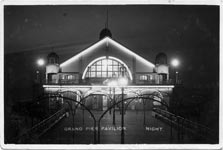|
GRAND PAVILION ILLUMINATED:
 Frederick Christian Palmer (1866-1941), known professionally as Fred C. Palmer, was the main public photographer of Herne Bay, in the early years of the 20th century, working from Tower Studio in Tower Parade on the Sea Front, where he took portraits. The photograph “Grand Pier Pavilion Night” ➂, which Palmer took when it was illuminated on the night of its grand opening on 3 August 1910, was used to promote that event. This photograph was rather successful and became widely available in Herne Bay, appearing in the local paper, as a postcard and on other printed material. The camera viewpoint appears to be slightly to the left at the pier entrance on the first storey of the Theatre Building, preceding the Pavilion. This off centre position enabled Palmer to record the foreshortening especially of the central row of gas lamps. Unfortunately, both buildings burned down, the Theatre in 1928 and the Pavilion in 1970. Frederick Christian Palmer (1866-1941), known professionally as Fred C. Palmer, was the main public photographer of Herne Bay, in the early years of the 20th century, working from Tower Studio in Tower Parade on the Sea Front, where he took portraits. The photograph “Grand Pier Pavilion Night” ➂, which Palmer took when it was illuminated on the night of its grand opening on 3 August 1910, was used to promote that event. This photograph was rather successful and became widely available in Herne Bay, appearing in the local paper, as a postcard and on other printed material. The camera viewpoint appears to be slightly to the left at the pier entrance on the first storey of the Theatre Building, preceding the Pavilion. This off centre position enabled Palmer to record the foreshortening especially of the central row of gas lamps. Unfortunately, both buildings burned down, the Theatre in 1928 and the Pavilion in 1970.
NOTE 78 :
 NOTE 78: Palmer produced postcards of civic events in Herne Bay that became popular leaflet handouts or souvenirs. Copies might well have been distributed to hotels, boarding houses, and even schools. So, as Harvey suggests, Duchamp could well have come across such a leaflet at Lynton College [Harvey 2005]. Regardless of its origin, Duchamp clipped Palmer’s entry promoting the “Grand Pavilion Illuminated” as found art on what came to be known as “Note 78” ➃. Created in 1913, this note begins: “As background, perhaps: An electric fête recalling the decorative lighting of Magic City or Luna Park, or the Pier Pavilion at Herne Bay.—garlands of lights against a black background (or background of the sea. Prussian blue and sepia)/Arc lamps.—Figuratively a fireworks—In short, a magical (distant) back drop in front of which is presented... the agricultural instrument—.” Then, as Professor Henderson observes, the rest of the note is devoted to technical issues documenting Duchamp’s decision that “the picture will be executed on two large sheets of glass about 1,30 x 1,40 m / one above the other (demountable)” [Henderson 1998, p.86]. This dimension was only speculative, because it was two years before the work on the actual “Glass” begun. Over time the dimension of the “Glass” developed, causing the intended ratio 1.08/1 for 140x130cm to become 1.3/1 for 228x176cm. NOTE 78: Palmer produced postcards of civic events in Herne Bay that became popular leaflet handouts or souvenirs. Copies might well have been distributed to hotels, boarding houses, and even schools. So, as Harvey suggests, Duchamp could well have come across such a leaflet at Lynton College [Harvey 2005]. Regardless of its origin, Duchamp clipped Palmer’s entry promoting the “Grand Pavilion Illuminated” as found art on what came to be known as “Note 78” ➃. Created in 1913, this note begins: “As background, perhaps: An electric fête recalling the decorative lighting of Magic City or Luna Park, or the Pier Pavilion at Herne Bay.—garlands of lights against a black background (or background of the sea. Prussian blue and sepia)/Arc lamps.—Figuratively a fireworks—In short, a magical (distant) back drop in front of which is presented... the agricultural instrument—.” Then, as Professor Henderson observes, the rest of the note is devoted to technical issues documenting Duchamp’s decision that “the picture will be executed on two large sheets of glass about 1,30 x 1,40 m / one above the other (demountable)” [Henderson 1998, p.86]. This dimension was only speculative, because it was two years before the work on the actual “Glass” begun. Over time the dimension of the “Glass” developed, causing the intended ratio 1.08/1 for 140x130cm to become 1.3/1 for 228x176cm.
SIGNIFICANCE:
Duchamp’s “Note 78” is significant because it connects his plans for the “Large Glass” to popular culture. This note is evidence of the fact that he was a pioneer in using pure personal and everyday experiences not only as source of inspiration but also as fabric by which to create art. Besides, Duchamp is known to promote this deeply useful, productive and healthy agenda – to propose art as a creative act inextricably intertwined with the ordinary daily life. This point exactly differentiates Duchamp from the past and turns him into a pioneer artist, whose ideas remain contemporary, transcending their time.
|

